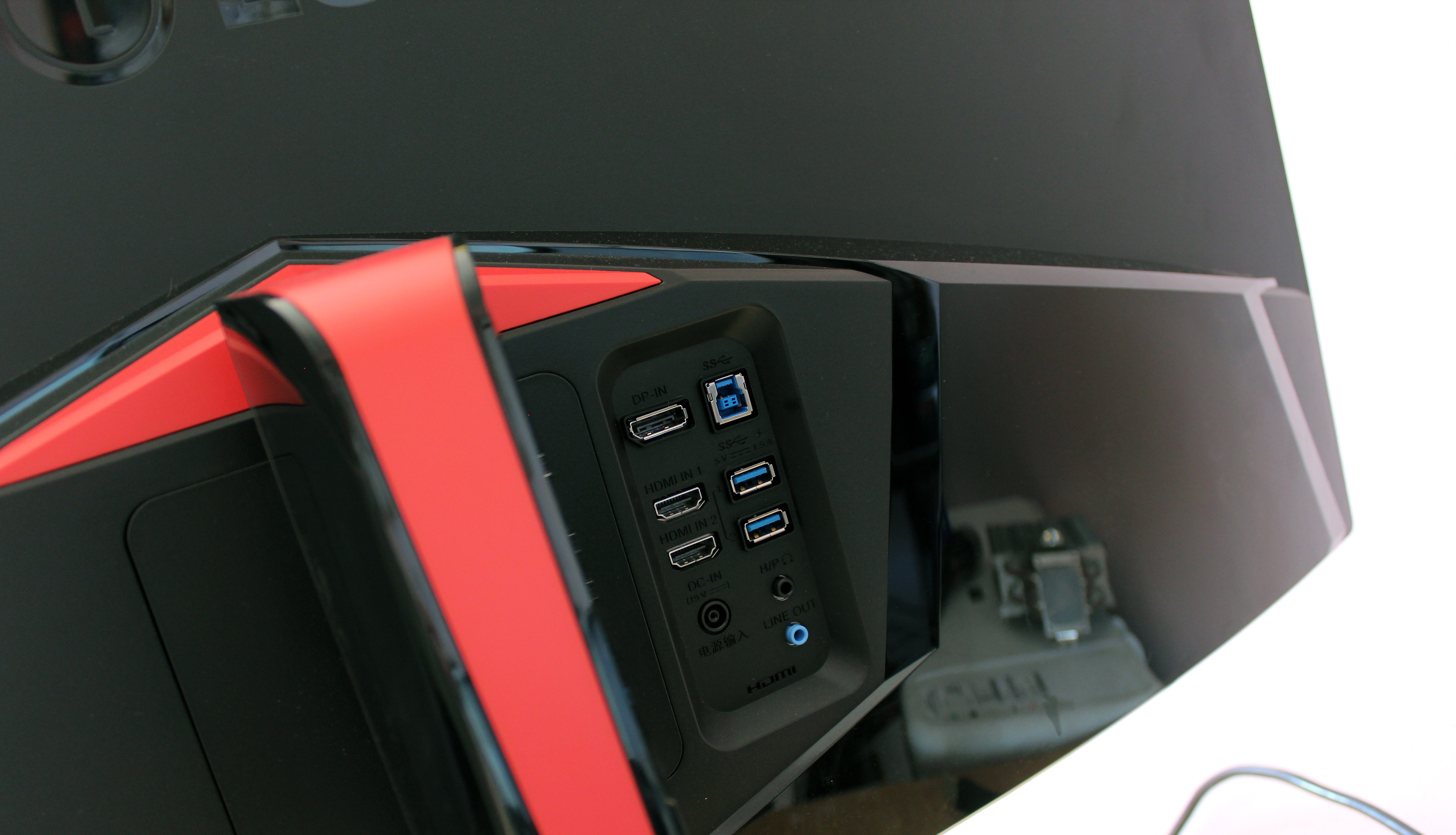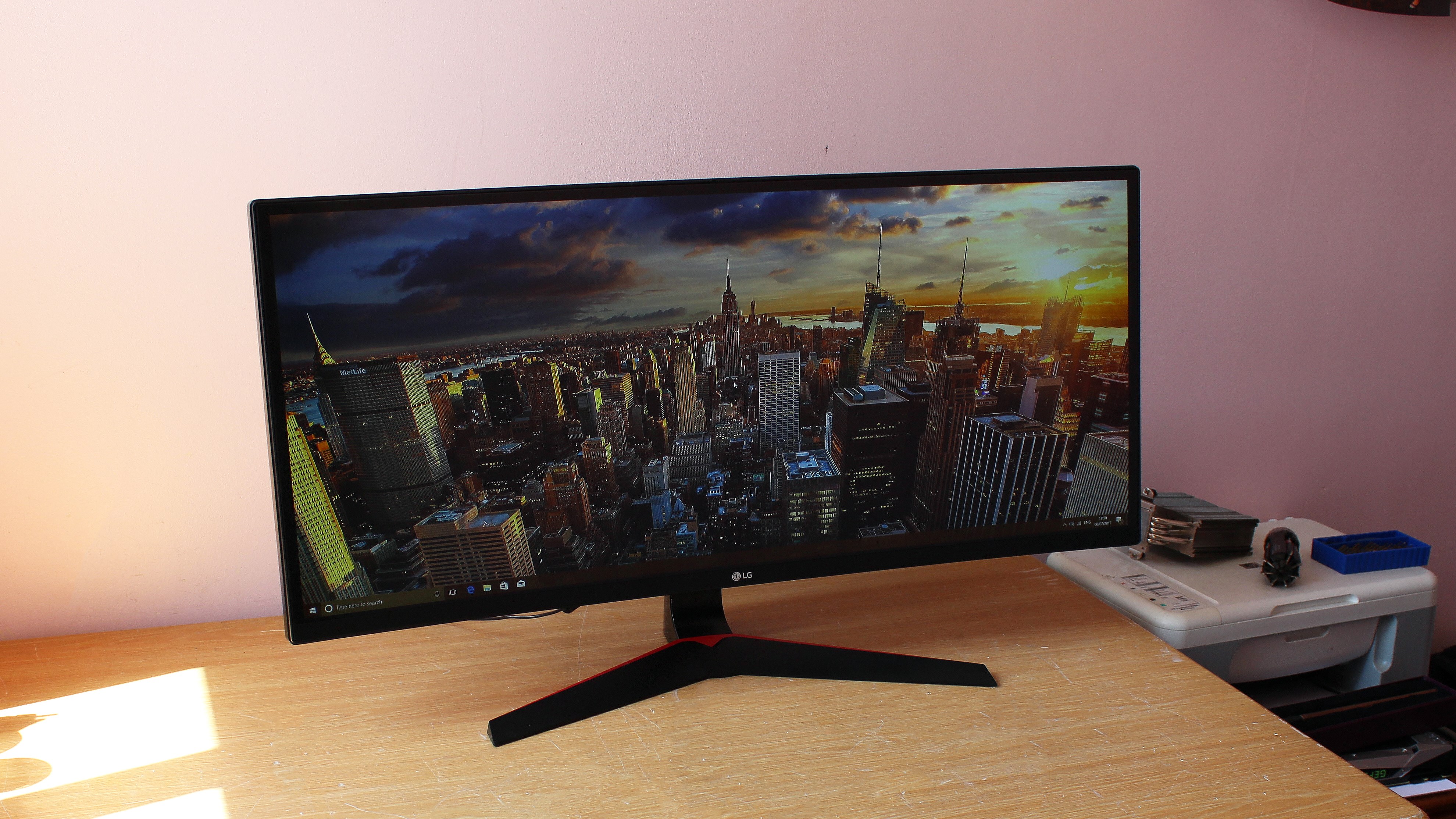TechRadar Verdict
LG’s curved panel delivers exceptional screen quality and a solid range of features for a lower price than its rivals – and the compromises that have been made to reach that lower price are sensible, rather than punitive. It’s an excellent and affordable option.
Pros
- +
Excellent image quality
- +
Curved 21:9 screen design
- +
AMD FreeSync
- +
Height adjustment
Cons
- -
Lesser resolution than rivals
- -
Ineffective gaming modes
- -
No speakers
Why you can trust TechRadar
The LG 34UC79G-B is one of the most intriguing monitors we’ve seen. Its 34-inch diagonal is huge, and it improves its gaming credentials with a gentle curve.
That’s not its only attractive attribute. It’s got AMD FreeSync, and the panel it runs on is IPS. It also costs $625 (about £480, AU$813) – far less than many of its rivals.
Design and features
Screens like this always look disarming at first. The 34-inch diagonal is vast, stretching across the desk, and the curve draws the eye.
However, when you sit closer, wide and curved screens make loads of sense. The 3,800mm radius makes for a gentle arc, so there’s no image distortion – instead, the sides tilt the screen towards the user. It’s discreet, not distracting.
The 21:9 aspect ratio is arguably more useful than taller 4K screens, too: the extra width is better for films, and it provides extra screen real estate for working. It’s great for gaming: racing titles have more immersion as scenery flashes past, there’s more room to manoeuvre in FPS titles, and RTS and MOBA games really benefit.
The LG’s price means that this 21:9 panel has a resolution of 2,560 x 1,080. That’s less than rival screens – both the AOC Agon AG352UCG and Acer Predator X34 use 3,440 x 1,440 – but they cost hundreds more than the LG.
The lesser resolution has its pros and cons. The LG’s pixel density of 82ppi (pixels per inch) isn’t particularly high – pixels are visible when you’re up-close, and 3,440 x 1,440 screens have a sharper density measurement of 110ppi. Games on those screens will look crisper than on the LG.
Sign up for breaking news, reviews, opinion, top tech deals, and more.
The upside, though, is that it’s easier to play games on this screen – the lesser pixel count means you don’t need a ridiculous GPU to get games running smoothly, and it also means that there’s more chance to take advantage of the LG’s 144Hz refresh rate.
The inclusion of AMD FreeSync is welcome. It runs at a low figure of 50Hz and a high of 144Hz, which means that you’ll benefit when games run between 50fps and 144fps. It’s better than both rivals: the AOC Agon AG352UCG and Acer have Nvidia G-Sync that peaks at 100Hz.
As ever, higher is better: the closer you get to 144fps, the more GPU frames you’ll be able to synchronise with the monitor’s refresh rate – so the smoother games will look.
The panel behind all of this technology is an IPS unit. It’s the most popular screen technology around today – it’s also used on the Acer Predator X34 screen – and for good reason. These panels tend to offer the best colour accuracy and great viewing angles, although they do sometimes struggle with black levels and response times.
The panel is secured inside a good-looking enclosure. The base is made from matte plastic that’s accented with red, and there’s more crimson along the back of the stand. Build quality is fine, and the screen feels sturdy on a desk despite its width.

There are no surprises when it comes to the LG’s adjustment options or connectivity. The screen has 120mm of height adjustment and can be tilted back and forward, and it’s compatible with 100mm VESA mounts. The screen can’t be swivelled, which is the norm for widescreens – the ergonomics of these panels don’t often support that kind of movement.
The LG is easy to set up out of the box – the stand clips into the rear of the screen, and the base attaches with a single screw – and its ports all face outwards, which makes connectivity simple. LG has included two HDMI 2.0 ports and a DisplayPort 1.2 connection alongside two USB 3 ports and an audio jack.
LG’s on-screen display takes up the entire right-hand side of the screen, which makes it larger than most OSDs – and given the number of options available, it’s almost too big.
It’s easy to navigate, with fast and accurate response from the joystick below the bottom bezel. There’s a quick settings menu to adjust brightness, contrast and volume, but the beefiest options are held in the Picture menu. Here it’s possible to choose a picture mode, tweak the color temperature, and deploy various game-friendly adjustments.
Those gaming settings are also housed in a quick-access menu that’s accessible when you first tap the joystick. This sub-menu switches between genre-specific screen modes, and it also has options related to the black equalizer, response time and AMD FreeSync.

There aren’t many downsides to the LG’s design. The bezels around the panel are quite thick, but that’s only a tiny aesthetic quibble. There aren’t any speakers, and the OSD joystick is a little wobbly.
For the most part, though, this is excellent – a sensible resolution and screen size paired with solid build quality and ample features.
Screen size: 34-inches
Native resolution: 2,560 x 1,080
Aspect ratio: 21:9
Refresh rate: 144Hz
Pixel density: 82ppi
Response time: 5ms
Viewing angle: 178°/178°
Brightness: 250cd/m2
Contrast ratio: 1,000:1
Ports: 2 x HDMI 2.0, DisplayPort 1.2, 2 x USB 3.0, 1 x audio
Built-in speakers: n/a
Dimensions: 831 x 450 x 399mm (WxDxH)
Weight: 8.6kg
Warranty: 3yrs
Performance
The LG 34UC79G-B started strongly in benchmark tests. Its brightness level of 259cd/m2 is a little better than LG’s quoted figure, and it’s bolstered by a black level of 0.19cd/m2 – which means the LG delivers a contrast ratio of 1,363:1.
The high contrast is important. It means colours will be vibrant, and it helps the LG deliver a wide range of different shades – even closely-matched tones will be easier to tell apart. And that excellent black level helps dark shades really pop – most gaming monitors aren’t this good when it comes to those inkier tones.
Those attributes are vital for gaming and for movies – so they’re important for a panel like this.
The LG delivered solid color accuracy. Its average Delta E of 2.28 is good, and its measured color temperature of 6,501K is stunning – exactly on the mark. Those figures will mean colours should appear as developers and directors intended.
They’re backed up by an sRGB coverage level of 92.1%, which is fine; the LG only fell short when displaying some red and pink shades.
We turned the LG down to a more conventional brightness level of 150cd/m2 – which is 34/100 on the screen’s brightness slider – and the 34UC79G-B continued to impress. Its contrast ratio remained a solid 1,302:1, and its colour temperature rose a little to 6,628K. That means the panel will be a tiny bit cooler, but it’s not enough to notice a change. The Delta E, meanwhile, improved to 0.74, which is stunning.
The LG continued to perform in uniformity benchmarks. It’s often harder for larger screens to maintain backlight accuracy, but that didn’t happen here: the LG kept its variance below 10% in most sectors, with that figure only rising to about 12% along the right-hand edge. That’s better than many other large gaming screens, and it’s not enough to prove noticeable during games or films.

Colors remained accurate, too – their temperature only deviated by about 5% across the entire screen.
Response time is another vital consideration for gaming screens, and the LG performed well. Its average response time of 10.3ms is excellent, with anything under 20ms fine for gaming.
LG sells this screen with three pre-configured gaming modes. Sadly, they all have issues. The first FPS mode artificially sharpens the screen to the point of distraction, and it changes the color temperature to a chilly 7,286K – a move that robs colors of vibrancy.
The second FPS option isn’t as sharp, but it ramps up the black level to 0.38cd/m2 – which brings the contrast down to 586:1. That’s half as good as the LG’s factory settings, and it hampers images; it may be designed to highlight darker areas during games, but it just makes images lack punch and depth. The Delta E declined to 3.1, too.
The third option, RTS mode, made the contrast and color temperature a little worse than the LG’s default settings, so it’s another mode we wouldn’t use.
The photo mode is also hindered by a chilly colour temperature, but the Cinema option is better – because it’s close to the LG’s factory settings.
We’d see the point of ramping up black levels if this was an eSports monitor, but this widescreen panel is designed to show off games and films at their best, so there’s no need to stray from the LG’s factory settings.

Verdict
In the most important category, screen quality, the LG 34UC79G-B delivers: it’s got a great contrast ratio and black level alongside vibrant, accurate colours, and it maintains good uniformity and viewing angles despite the screen’s curve and width. Response times are rapid, too.
The $625 (about £480, AU$813) price is good, undercutting the competition without compromising on too many features. The resolution isn’t as high as rivals, for instance, but it’s fine – better for cheaper graphics cards and for AMD FreeSync compatibility. Adjustability and build quality are good.
There are few issues. The default screen settings are so good that you won’t need to use the iffy gaming modes, and there are no speakers.
The LG 34UC79G-B offers great screen quality, a solid curved design with good features, and AMD FreeSync – all for less than its competitors. It’s an exceptional option if you’re after a curved gaming panel but can’t afford the market’s more expensive models.
Mike has worked as a technology journalist for more than a decade and has written for most of the UK’s big technology titles alongside numerous global outlets. He loves PCs, laptops and any new hardware, and covers everything from the latest business trends to high-end gaming gear.
